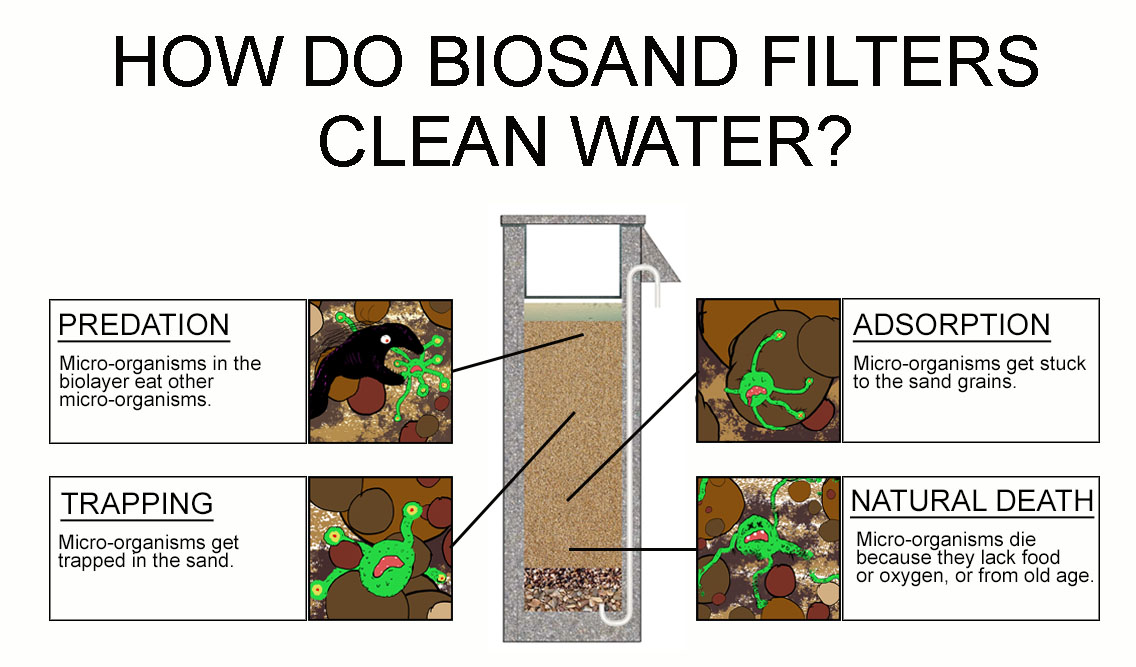BioSand Filters: Reliable, Affordable, Sustainable Clean Water for Life
At OHorizons, BioSand Filters are our favorite drinking water solution. Through our initial BioSand Filter pilot projects, we have provided over 1200 people in Ecuador, Mali, and Bangladesh with clean water. Now that we’ve had time to test and perfect our BioSand Filter design and operation, we plan on delivering clean water access to an additional 5,500 people in 2016 alone! Read on to learn more about the awesome, low-tech water filters that are making this possible!
The BioSand Filter (BSF) is a simple and affordable low-tech water filtration device designed for household use in developing countries. Using sand, gravel, and natural biological processes, the BSF removes pathogens from drinking water. A pathogen is anything that can produce disease. In the case of drinking water, this can include bacteria, protozoa (single-celled organisms), helminths (parasitic worms), and viruses. The BSF relies solely on gravity, not any mechanized or moving parts, making it ideal for off-grid communities. If properly cared for, a concrete BSF can last for more than 20 years and requires very minimal maintenance and cleaning, making it an extremely durable, sustainable, and effective means of water filtration.
BioSand Filters are a point of use technology. As suggested by the name, this means the water is treated at the point it is used or consumed. This allows users maximum control over the cleanliness of their water and reduces the chances of recontamination.
There are many point of use technologies available, but OHorizons has chosen to focus specifically on the concrete BioSand Filter. This is because we feel it is the most accessible, affordable ($15-65), easy to use, easy to maintain, and most durable design. When the concrete BioSand Filter is properly installed and used, it removes over 99% of protozoa and worms, 98% of bacteria and over 70% of viruses.
Image retrieved from http://resources.cawst.org/
The history of BSFs dates back to the early 1990s when Canadian engineer Dr. David Manz developed his first BSF prototypes at the University of Calgary. Dr. Manz envisioned creating an adapted household version of the slow sand filter, which municipalities around the world have used since the beginning of the 19th century. His research and testing resulted in the concrete BSF design (pictured previously) that is now used in countries around the world.
To produce the concrete filter body, a steel mold was fashioned. Over the years, the design of concrete BSFs and corresponding steel molds have been updated periodically to increase pathogen removal; however, the process of manufacturing filters has largely remained the same.
Concrete is poured into the mold form and left to cure overnight. After 8-12 hours, the mold can be removed, leaving the concrete filter body. This process is called de-molding. After the concrete has fully cured, the filter is brought to its final destination where it is filled with filtration media. The final product is an approximately 3 foot tall concrete household appliance that is filled with carefully prepared and measured layers of sand and gravel. Once installed, the filter should not be moved. Moving the filter could disrupt the biolayer and the sand within the filter, potentially inhibiting pathogen removal. The separation gravel (smaller gravel) prevents the sand from reaching the lower levels of the filter and clogging the outlet tube. The drainage gravel (larger gravel) prevents the separation gravel from clogging the outlet tube. The outlet tube is at the bottom of the filter and clean water passes through this tube and out the filter where it can be consumed.
Many microbiological organisms live in water. They are too small to see with your naked eye, but they are there. Some of these microbiological organisms include harmful pathogens. As shown in the diagram above, BSFs separate microbes, including pathogens, from drinking water through four different processes: Mechanical Trapping, Adsorption, Predation, and Natural Death. Let’s go over these processes in more detail and learn about the most exciting aspect of the BioSand Filter, its biological layer!
When water is initially poured into the BSF, the larger microbes get trapped towards the top of the sand. During the first few weeks of use, as dirty water is poured into the filter, these microbes continue to accumulate towards the top of the sand column and settle into their new home. This ecosystem of microbes at the top of the sand is the biolayer and is usually fully formed within a month of using the BSF. Predation (microbes eating other microbes) occurs in the biolayer and is vital for pathogen removal inside the filter. When the biolayer is fully formed, 98% of pathogens are removed from the water; without it, mechanical trapping, adsorption, and natural death will only remove 30-70% of pathogens. It is critical that a BSF is used every day, so the biolayer can be fed and continue to function properly.
Microbes that do not get eaten in the biolayer will be removed from water in lower layers of the sand through mechanical trapping, adsorption, or natural death.
Critical to the proper functioning of the filter and the biolayer, is the pause period. The BSF is designed for intermittent use, meaning water should be poured into the filter intermittently, not continuously. When water is not flowing through the filter, this is called the pause period. The pause period should be a minimum of 1 hour and a maximum of 48 hours. If the pause period is too long, the microbes in the biolayer may start to starve and die, impacting the biolayer’s effectiveness. The standing water above the biolayer may also start to dry out, which can also kill the biolayer. If the pause period is too short, there is not enough time for natural death to occur at lower levels of the filter, meaning those pathogens may remain in the water that comes out of the filter. Similarly, the microbes in the biolayer will not have enough time to consume the majority of pathogens in the biolayer.
It is recommended to use water from the same source every time when using the filter. Typical water sources for BSFs include surface waters like lakes, rivers, streams, and ponds. Rain water, boreholes, tubewells, or piped water can all contain pathogens and can be used with a BSF as well. Over time, the biolayer becomes adapted to a certain amount and type of contamination from the source water. If you change the water source, for example, when the rainy season starts, it will have a different level and type of contamination. It may take the biolayer several days to adapt to the level of contamination and nutrients in the new source water. During this time, users can continue to use their BSF but should use a secondary disinfection method AFTER the water has gone through the filter, such as chlorination or boiling. Users should never put chlorine or chlorinated water into the filter; this will kill the biolayer.
There is a science to designing parameters of a BSF, and its corresponding mold, in order to maximize efficiency, practicality, and pathogen removal. Years of research has been conducted both in the lab and the field to enhance the BSFs performance. For instance, to keep the biological layer alive, it is essential that it is both wet and able to access oxygen. In order to safeguard the biolayer, it has been learned that it is optimal to have 5 cm of standing water above the sand and to use a diffuser basin to prevent water from splashing in all at once and disrupting the biolayer.
Some of the latest BSF technical findings include:
“The reservoir volume (water poured into the filter) should be equal to the pore volume (water held in the sand) to ensure that all of the water dosed into the filter remains in the filter for at least one residence time.
Increased sand depth aids in virus removal and inactivation.
The height of the water above the standing water is a major determinant of the filtration rate (1).”
BioSand Filters are quite simple to use and comparable to taking care of a houseplant. The most important part of maintenance is making sure the biolayer remains healthy by feeding it 1-4 times a day with contaminated water. Once fed, the biolayer needs time to digest and recover. Again, this is called the pause period. There needs to be at least a one hour pause period in between each use and we recommend several hours for effective and efficient performance . Much like a houseplant, the biolayer cannot survive if there is too much or too little water.
As a general rule, the concrete BioSand Filter can last more than 25 years, if properly installed and used. The sand and gravel do not have to be replaced and BSFs require very little cleaning. If the flow rate of the filter becomes an issue, due to the use of turbid or sediment concentrated water, the sand can easily be cleaned by using a simple procedure called the swirl and dump technique. The swirl and dump technique consists of lightly swirling the top layer of sand in the filter with the palm of your hand, thereby slightly altering the surface. After this has been done, the standing water becomes cloudy. It should be removed, dumped away, and replaced with new water. This process can be repeated as many times as necessary to regain the desired flow rate.
The OHorizons designed BSF will filter 11 liters per use. In other words, 11 liters of drinking water are filtered each time a load of water is poured into the filter. Keeping in mind that the BSF should be used intermittently, the filter owner can get anywhere from 11 to 44 liters of water or approximately 3-12 gallons daily.
We stress the importance of using a clean safe water storage container to collect and store the water as it flows out of the BSF outlet tube. This is very important to prevent the recontamination of the water.
There are numerous types of BSFs currently being studied and implemented. In addition to the concrete BSF, there are commercial plastic versions, a stainless steel model, and numerous DIY plastic bucket plans. OHorizons has engineered a Wood Mold to serve the same purpose as the aforementioned steel mold in the production of concrete BioSand Filters.
The OHorizons’ Wood Mold is a breakthrough because it allows on-the-ground organizations and communities to manufacture and install BioSand Filters for a fraction of the upfront costs as traditional methods, meaning more people can get clean water, faster. Stay tuned, our next blog post will be entirely dedicated to our Wood Mold. If you want to learn even more about BioSand Filters, be sure to download ourIntroduction to BioSand Filters document on our Resources page.
If you enjoyed this post, please click here to sign up for our email updates! You'll be able to stay up-to-date with the life-changing work we're doing through our clean water initiatives.
REFERENCES:
Centre for Affordable Water and Sanitation Technology (CAWST). 2015. “Research Update Biosand Filter



